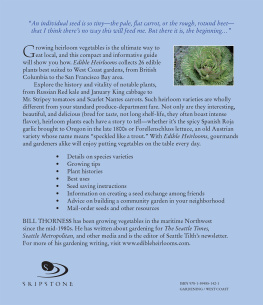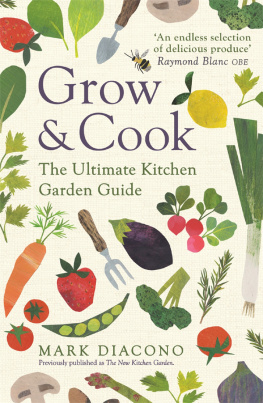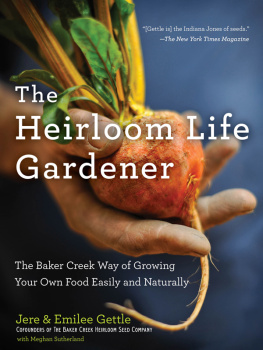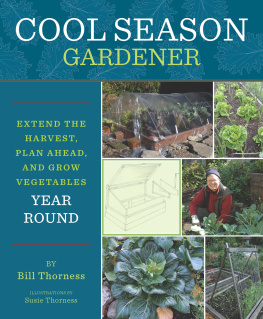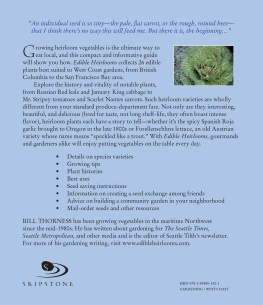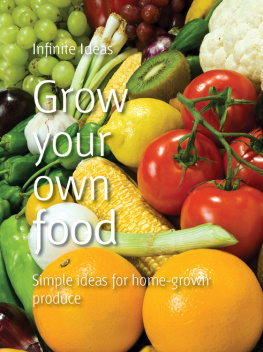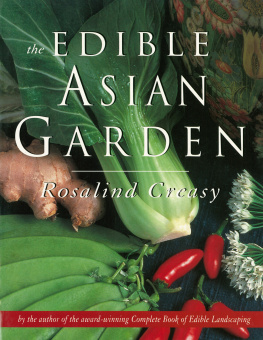EDIBLE HEIRLOOMS
heritage vegetables for
the maritime garden

BILL THORNESS

TABLE OF CONTENTS
ACKNOWLEDGMENTS

My greatest thanks go to a number of people who helped me plan and research this book. They include garden educator Carl Elliott, David Cavagnaro of Seed Savers Exchange, Peggy Cornett of the Center for Historic Plants at Monticello, Josh Kirschenbaum and Tom Johns of Territorial Seed Co., Matthew Dillon at Organic Seed Alliance, and organic farmer and educator Michael Ableman. Thanks to Skipstone Press acquisitions editor Dana Youlin, and to the wise, good-humored copy editor Alice Copp Smith.
The support and first-reader task graciously offered by my wife, Susie Thorness, has helped me immensely, and it has been very gratifying to collaborate with her as the artist for this book.
The readings of many authors have influenced my work, but most particularly the works of the Kentucky farmer and philosopher Wendell Berry and the inquisitive gardener and omnivore Michael Pollan. More specifically, I have learned much from the garden writing of William Woys Weaver, Amy Goldman, Benjamin Watson, and Rosalind Creasy.
To augment my own research, I appreciate the efforts of my good friend Sylvia Kantor. Also, I am thankful for the librarians and wonderful book collection at the Elisabeth C. Miller Horticultural Library at the University of Washingtons Center for Urban Horticulture, which will get all my gardening books when I finally return to the Earth to become compost.
But this book is not just a product of my interest in heirlooms and recent research. It also stems from my gardening education, which I realized when writing has long been directed toward heirlooms and seed saving as well as low-input, organic gardening practices. Along with the perennial guidance of Seattle Tilths Maritime Northwest Garden Guide, the writings of John Jeavons, Binda Colebrook, William Head, and, especially, Steve Solomon have been invaluable. For two decades of learning, I want especially to thank the current and past educators at Seattle Tilth, and commend their services to anyone in the Puget Sound area who wants to learn to grow their own food.
Finally, I would like to dedicate this book to my late father, Erick G. Thorness, who was a farmer, and to my extended family, which includes many who worked the land.
INTRODUCTION
T here is a moment after I sprinkle seeds onto the surface of my garden soil, before covering them up, when they blend with the soil and mineral particles and nearly disappear. An individual seed is so tinythe pale, flat carrot seed, or the rough, rotund beet seedthat I think Theres no way this will feed me. But there it is, the beginning.
Its one time when I really drop down to ground level and get my eyes close to the garden soil. I scatter compost over the row of seeds and press it down with the edge of my palm, compacting the soil to snug the seeds into it. I picture each seed pulling moisture from the surrounding earth as it begins the process of sprouting to life.
Gardening is a contact sport for people as well as seedsplunge in and get your hands dirty. Muddy knees, backaches, and grimy nails are all part of the game, along with sowing, weeding, mulching, and, of course, harvesting. Tamping down the row of seeds is the civilized methodgardeners used to stomp on the bed after planting, daring the seed to sprout, dancing for it.
I come from a farming family, and my earliest memories involve dirt, bare feet in garden rows, and hollyhock flower stalks towering over my head. But rarely as a boy did I consider the how and why of growing food or, frankly, take much interest in the kinds of plants being grown. It was simply the farm and the garden, and things just grew.
Becoming a gardener, as an adult, has been a journey of discovery, one that I expect will continue as long as I practice it. Learning the best techniquestried-and-true ways that will yield consistent resultshas been an essential part of my education. Before I migrated from the hot, dry plains of North Dakota to the verdant, temperate Pacific Northwest, my climate experience had consisted of beginning each year with blizzards and temperatures 40 degrees below Fahrenheit, which after a quick, muddy spring gave way to a hot summer of 100-degree days and the occasional rain that showed up in terrific thunderstorms.
What a difference to experience Cascadia, the ever-green landscape seemingly defined by water, whether it be the rivers, lakes, ocean, or omnipresent rain. My grandmother, who had moved to the Coast when I was still a kid, would tell my mother in their regular phone calls about the Port Angeles grass that was green all winter, or the tulips that were in full bloom while I was still shoveling snow.
Once I arrived in Seattle, I was amazed by the fervor of growth. With such abundant natural beauty, being a gardener seemed almost required. And becoming a gardener, however challenging through inevitable mistakes along the way, seemed so much simpler in a place where things will just grow!
Almost from the first, I was attracted to heirloom vegetables. Twenty years ago I didnt think of them as such, but I was inspired by the idea of an old variety being kept alive from year to year as seed is passed from one generation to the next. Now some of these seeds grow in my gardenproducing the same plant with the same-sized fruit in the same number of days as they did for Thomas Jefferson, or Native Americans, or settlers, or perhaps even my ancestors when they inhabited the Old Country.
The stories that come with these treasured seedsa variety that was the favorite of royalty, a variety whose seeds were used as voting tokens by ancient peoples, a cultivar that was so popular it paid off the family mortgagefurther spur the imagination. What kind of trellis did Jefferson build for his tall Alderman pea vines, and how did the Colville Indians cook with their Inchelium Red garlic? Stepping into my heirloom garden is not simply an education about how things grow, or a culinary expedition to see whats for dinner. Its like a living lesson on human history and the nature of civilization.
One of the greatest principles Ive learned is to plan my garden with one eye on the future and keep the other eye on the past. What Ive learned about biodiversity and ecological systems affects my understanding of nature and my impact on it. A desire to learn from the past has also directed me back toward heirloom plants.
Ive learned that part of gardening with heirlooms is sharing in the collective wisdom. With that in mind, I began to research this book. Edible Heirlooms is focused on the growing conditions of the Pacific Northwests maritime climate, found in coastal areas from San Francisco to Vancouver, British Columbia, from the base of mountain foothills to the Pacific Ocean. The book is a collection of more than two dozen vegetables for which heirloom varieties are available. It is not an exhaustive plant list, and you may grow heirloom varieties or plants not in this book. Perennial vegetables were not included, for example, and a few vegetables were omitted due to space constraints, lower popularity, or lack of good short-season heirloom choices. But in these pages youll find information on many commonly available heirloom varieties that grow well in a cool, shorter-summer northern climate, and tips on how to grow them in our unique weather conditions. And on the books accompanying website, www.edibleheirlooms.com, the exploration of heirloom vegetables will continue.

